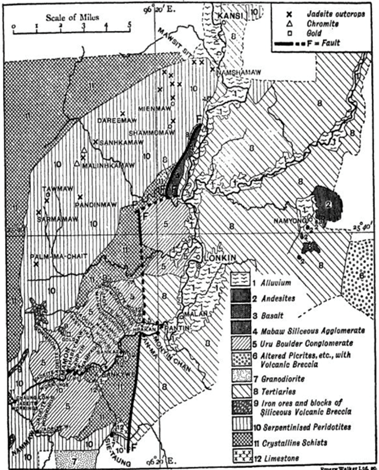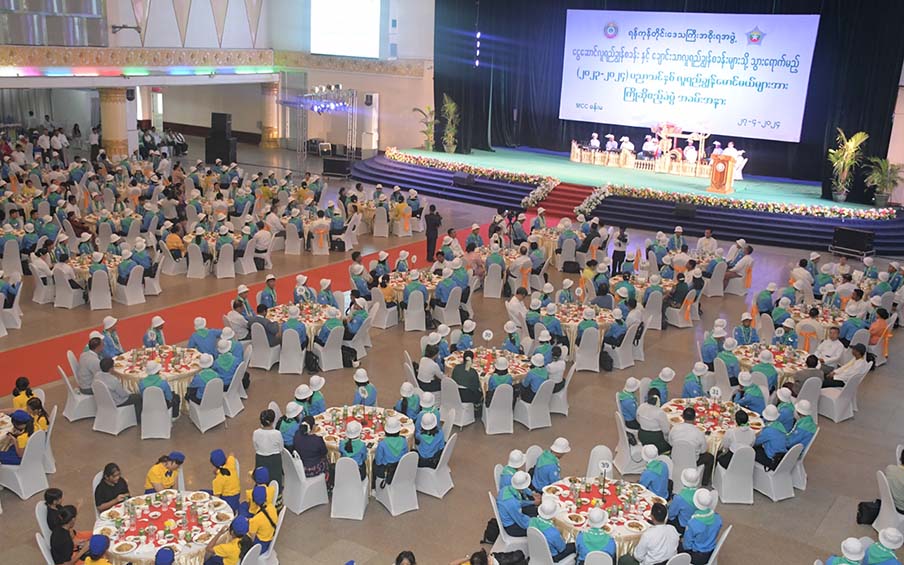By THAN HTUN (GEOSCIENCE MYANMAR)
EPISODE:31
On the Jadeite and Other Rocks, from Tammaw in Upper Burma
Professor Max Bauer of Marburg University reported on the petrology of jadeite and other rocks from Tammaw in Upper Burma in 1895. While his report provided a comprehensive analysis of the characteristics of jadeite and other rocks, due to space constraints, only the following excerpts could be extracted to offer a general overview of Burmese jadeite.
In the following pages, I propose to describe the rocks collected by Dr Noetling at the jade mines near Tammaw in Upper Burma, which are now in the collection of the Geological Survey of India. These specimens, including the jadeite and the serpentine (the most important), bear all the characteristics of true rocks.
Jadeite
The jadeite forms a fine-grained mass, chiefly white, and bearing at first sight a certain resemblance to marble. The size of the grains is not uniform; they are at times so small as to be indistinguishable by the naked eye, while at times, they are somewhat larger, in which case they are characterized by an elongated form and distinct cleavage. On account of the smallness of the grains, no single individual could be separated, and further information could be obtained only using the microscope. I will, however, first describe the general appearance of the jadeite.
General Characters
The colour of all specimens under my observation is a clear snow-white on fresh fracture; this monotonous white is, however, relieved by beautiful emerald-green spots, which represent the really valuable part of the stone. They are of variable size, sometimes as large as a lentil or a pea, attaining a diameter of several centimetres. The colour is, in many cases, very intense, but in others, it is quite pale, at times forming a faint film-like covering of larger or smaller portions of the surface. As it approaches the white mass of the rock, the colour changes abruptly. However, there is no well-defined boundary between the two. The green colour is due to the presence of a small quantity of chromium, for powder of an intensely green colour gives an unquestionable Cr. reaction before the blowpipe: this, however, is less distinct when the paler powder is used and is absent in the white portions of the rock. In the inner portions, when fresh, the lustre is vitreous, but towards the surface, it becomes somewhat duller.
Specific Gravity
Special care was exercised in the determination of the specific gravity because, in samples of jadeite from Bhamo, which might perhaps be considered identical to specimens from Tammaw, it was found to be very low. The average specific gravity of the Tammaw jadeite is about 3.3, while Issel gives that of two specimens of green jadeite Bhamo as 3.10, which corresponds with the values obtained by Damour. Mallet states that the specific gravity of the Tammaw jadeite is 3.24.
Microscopic Characters
The microscopic examination shows that the groundmass is composed of a confused aggregate of irregular prisms, varying in size; their length and breadth being in some cases the same and nearly equal to 1mm, but as a rule, the prisms are elongated, their length considerably exceeding their breadth. In no case, however, did I observe a breadth of less than 0.1 mm. The groundmass of the jadeite is perfectly pure and without a trace of any accessory mineral. The prisms are perfectly colourless, except at the boundary between two individuals or along small cracks, where a slight discolouration may be seen, probably due to subsequent infiltration. The green spots always retain their colour even in slices: it is, however, very pale, even in cases in which it was originally intense. In very pale sections, no pleochroism is noticeable, but thicker slices are slightly dichroic, with the colours ranging from bluish to yellowish green. The prisms are, at times, colourless in places. In the centre of the green spots, they are coloured, but as they approach the surrounding white groundmass, they begin to lose their colour and become partly green and partly white. Hence, we see that the green patches in the white ground cannot be due to an aggregation of green mineral grains at certain spots, but we must imagine local impregnations that took place using a colouring matter containing chromium in the solution. The green prisms are exactly similar in every respect to the white ones, with the sole exception of their different colour and so on.
Serpentine and Olivine
The groundmass of the serpentine is dense, appearing completely homogeneous, with a very dark, somewhat brownish-green colour, which spreads evenly over the whole surface. The fracture is uneven and splintery. Hardness considerable, exceeding that of pure serpentine: apatite is distinctly scratched in some instances. Under the microscope, the cause of this anomaly is at once evident, for the specimen is seen to be an altered olivine rock, the alteration of which into serpentine is quite complete, but the process of serpentinization is proceeding in the usual manner along cracks and fissures. In microscopic sections, the olivine is perfectly colourless and transparent; in thick slices, however, it shows a greenish-yellow tinge. It forms an aggregate of rather coarse grains, which in several instances have a diameter of more than 1 cm. They are always irregularly circular, with no indication of crystal faces being traceable. The olivine individuals and also the aggregates formed by the small grains are intersected in the usual manner by strings of serpentine of a greenish-yellow colour, which usually show distinct and very fine fibrous structures, running in most cases parallel to the walls of the small fissures: in a few cases, however, they are perpendicular to the walls. The rock is, therefore, a fibrous serpentine, very similar to chrysotile, and closely resembles it in the vividness of its polarisation colours and so on.
Magnetite and other Accessory Constituents
Except for numerous small black grains with a metallic lustre, no other minerals but olivine and serpentine can be seen. These black grains, which have a diameter of one millimetre, are magnetic and, hence, are probably magnetite. Some of the grains are not magnetite. These grains are unquestionably the source of the Cr, which permeates portions of the jadeite and produces green patches. In the specimens under observation, however, no mineral can be identified as chromite or picotiter; if, however, a larger number of specimens were examined, I do not doubt that sections of both minerals would be found. A specimen of the serpentine rock, which had been freed as much as possible from magnetite, gave a specific gravity of 2.838, etc.
Pikrolite
The percentage by volume is olivine 36.79 per cent and serpentine 63.21 per cent. These figures are, of course, not correct, but they give a very fair idea of the composition of the groundmass and certainly prove that no more than one-half of the original olivine has been altered into serpentine. The newer portions of pure serpentine, usually observed in connection with this form of alteration, are not absent in the present case. Strings of pikrolite, in particular, may be seen running through the rock. These veins are of a lighter colour than the chief mass of the rock and are, as a rule, very narrow. Some, however, attain a thickness of nearly two centimetres. Some specimens, the outer surface of which is composed of pikrolite, exhibit the characteristic course, straight, striated appearance, producing the effect of a slickenside, and one of these specimens gives unmistakable evidence of the tremendous crushing and pressure. On fresh fracture, the pikrolite has a faint fatty lustre, but on the natural surface, this lustre is much more marked. The colour is light green, with a distinct greyish or yellowish tinge. Under the microscope, the pikrolite is light yellow, almost colourless, and not pleochronic. It can hardly be distinguished from the surrounding Canada balsam and must, therefore, have the same refractive index.
Albite-hornblende rock
The specimen under my observation is about the size of the fist and formed part of a large boulder exhibiting both rolled surfaces and fresh fracture. The rolled surface is brown owing to impregnation by hydroxide of iron, the colouration extending for some distance within the rock but gradually fading and eventually disappearing. At first glance, one would be inclined to identify this rock as a saussuritic gabbro owing to the appearance of the fractured surface. The fine white, sugary groundmass contains grains of brown mineral, which cleaves easily and has a metallic lustre on the cleavage faces. Examination proved, however, that these two parts are neither saussurite nor diallage, and hence the rock is not a saussurite gabbro but represents a new type. The beautiful, snow-white groundmass is almost indistinguishable from some saussurites, as, for example, from that of Hamburg near Frankenstein in Silesia. It has the hardness of felspar and fuses with great difficulty before the blowpipe. The specific gravity of the two fragments was 2.599 and 2.576, respectively, which gave an average of 2.587.
Microscopic Characters
Under the microscope, the groundmass is seen to be a homogeneous aggregate of very small, irregularly rounded grains, varying in size from .02mm to a fourth or fifth of that size. These grains are almost perfectly pure, enclosures being absent, with the exception, perhaps, of a few small liquid enclosures with moveable bubbles. The grains are perfectly transparent and colourless, and between them occur foreign particles, which, however, are never included in them. The white grains show no cleavage faces but are crossed in one direction by a series of fine cracks, indicating a perfect cleavage.
Hornblende
The brown mineral resembling diallage, scattered through the white groundmass, has been proven to be hornblende. It occurs in single crystals of various sizes, the largest being nearly 4 cm. by 2 cm. This, however, is less than the original size of the crystal on the surface of the specimen and has been considerably broken. As a rule, the crystals are smaller but are always as large as a pea. They are not numerous, being scattered throughout the rock. Their outline is generally irregular, although, at times, rough crystal faces can be made out. The colour is that of brown hair, but sometimes grey, and the cleavage faces have a metallic lustre, resembling diallage or bronzite. Each crystal is bounded by a green margin, while the surrounding groundmass is also coloured green, and so on.
Hornblende-Glaucophane Schist
This specimen has a dark brown surface; in some places, it is rough, and in others, it is smooth but not rolled much. It is a schistose rock of an intense emerald to grass-green colour and bears a strong resemblance to smaragdite. A closer examination, however, at once reveals the fact that it represents an aggregate of greyish hornblende individuals, largely permeated by green enclosures, which impart to it its remarkable colour. The greyish portions pass in places into a deep green, but in other places, again, the green colouring matter is absent.
The hornblende individuals are most irregularly intermixed and show no signs of definite arrangement. They attain a length of as much as three and a breadth of as much as two centimetres. They have no crystalline outlines, but their cleavage is perfect, the angle between the two prismatic cleavages averaging 124 ½ ˚. The specific gravity of the whole mass -not that of the pure hornblende- was obtained from two pieces of rock, the values being 3.112 and 3.126. The characteristics of glaucophane and augite could not be described due to restricted space.
Geological Age
Noetling believes that the jadeite and serpentine penetrate the surrounding tertiary sandstone, while nothing is known about the relationship between the occurrence of the two other rocks and the jadeite. Noetling’s view necessitates the assumption of an eruption of jadeite and another of olivine rock, following one another, but the petrological composition of these rocks is not favourable to such a view, which would include them among the tertiary eruptive rocks. Judging by the petrological characters, we must consider them to represent a system of crystalline schists.
Now, there is no doubt that in former geological times, olivine rocks were produced by volcanic eruptions. Nowhere, however, have rocks of this nature been found in beds of such modern date, being, according to Noetling, not older than of Miocene age. To consider the jadeite as an eruptive rock would be entirely unjustified, for neither in the older nor yet in, the more recent series of eruptive rocks has any rock of the nature of jadeite been found. In Turkistan, however, it has been proved to be embedded with nephrite in the crystalline schists (gneiss and mica schist), and it belongs to that series.
I have repeatedly stressed the fact that these rocks must have been subjected to great pressure, which can only be accounted for by folding. I do not assert for a moment that the above arguments are absolutely convincing. Still, they certainly support the view which best accords with the petrological evidence, while the stratigraphical conditions observed by Noetling in the mines at Tammaw fully bear out this.
References:
Bauer Max, 1895: On the jade and other rocks, from Tammaw in Upper Burma (translated by Dr F Noetling and H H Hayden), Records of Geological Survey of India, Vol. XXVIII, Part 3.















